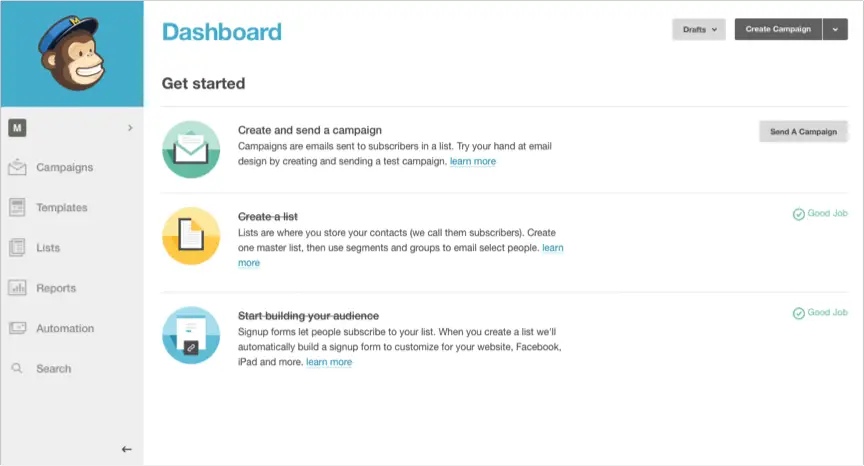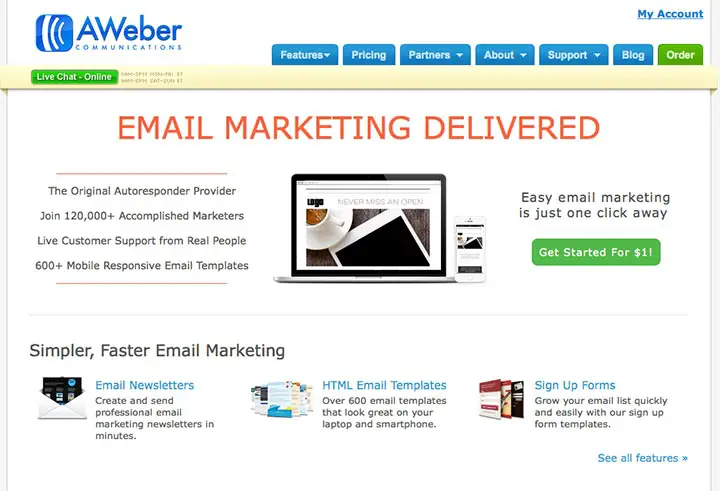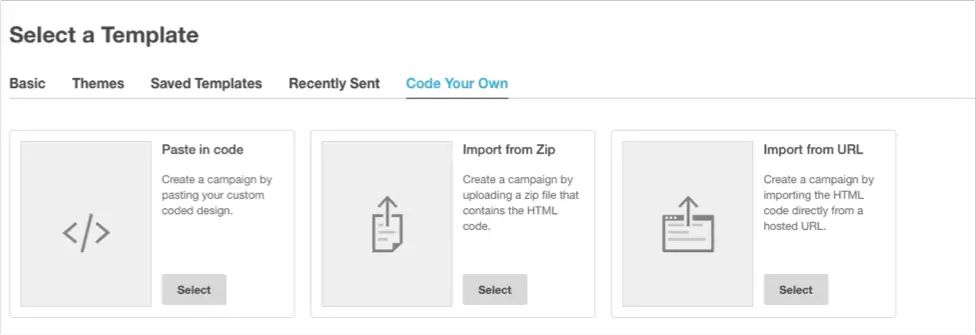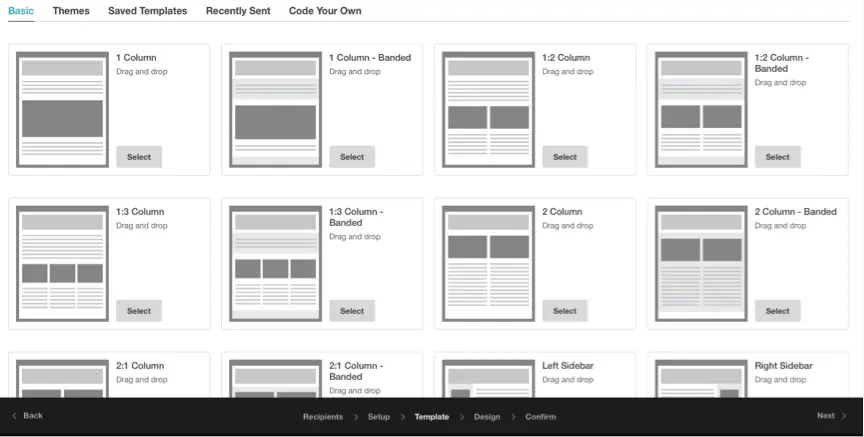I’ve said it before and I’ll said it again. As an author, your email newsletter is one of the most important elements of your author platform and you shouldn’t consider doing anything until you have an email list in place.
In order to build a long-term relationship with your readers, you need to establish some form of constant engagement with them. If you are constantly engaging with your readers, you will seem more familiar to them, meaning they will be more inclined to spend their hard earned money on your books.
This is where email marketing comes in
There are many methods you can use to engage with your readers. For example; social media, meet and greets, book giveaways or regular blogging. One of the most effective methods of engaging with your audience, and consequently building a more loyal fan base, is through email marketing.
If you don’t use an email marketing provider, you should start right now.
You can use email marketing newsletters to let your fans know about book signings, what you’re writing at the moment, if any of your books are on sale or just to get them to know you a little better as an author. If you have a loyal fan base that is involved in your work and knows what you’re up to, I can guarantee you’ll sell more books. It’s all about engaging with your audience.
Quite simply: Loyal email subscribers = Loyal customers.
At this point you may be thinking, “That’s great, but where do I start?”
Well you start with this article of course. I’ve put together a comparison of some of the biggest email newsletter services and have listed the pros and cons for authors.
Which email marketing provider is the best?
Websites such as Get Response, (www.getresponse.com) offer a variety of features, such as split testing (see this article on website conversion), landing page design, along with a variety of tools to enable you to design an email template for your mailing list.
Get Response has a great reputation, and would be especially helpful to you if you require additional tools that aren’t email marketing related (such as building landing pages).
However, as this article is all about email marketing, it seems appropriate to focus on a couple of email newsletter providers that are built for email marketing purposes alone.
Let’s take a closer look at two of the most popular email-marketing providers, and weigh up whether either of them is right for you.
The two main competitors to look out for are AWeber and MailChimp. These two providers include all of the relevant features that authors would need to build their readership. Both of these services provide tracking features that analyze each individual customer, highlighting exactly who is engaging with your newsletters and who is ignoring them.
MailChimp vs AWeber – The Showdown
MailChimp: Fun, Free, Simple, beautifully designed, and packed with personality.
AWeber: Robust, practical, well established and serious about what they do.
Sure, they both seem to have their advantages, but which one is best for you? Here’s a breakdown of the most relevant features:
User interface
For me, Mailchimp’s user interface is second to none.

The layout is so well considered that there really is no need for any tutorials to get you started. Everything is where it should be and just makes complete sense. On the left hand side, you’ll see a navigation bar where you can select “campaigns” to get started on your first campaign, or simply click the first option under that “get started” heading on your home screen.
From there you will be guided through steps on how to create your email template, who you want to send it to, and when you want it to be sent. Each step will lead you to the next, and when you first log in you will be given the option for a guided tour through the site.
Building on this, MailChimp is beautifully designed; the entire layout, color scheme, overall look of the website, and the copy on the site is all very well considered, simply designed and aesthetically pleasing.
This may not seem important, but if you think about it, you’re using the website to design something beautiful for you so it’s only right that they have demonstrated professionalism in their own website design.
(On a side note: MailChimp add humor to every part of their website, down to very small, insignificant bits of copy. This is a small point, but it does put a smile on your face when you’re creating a campaign.)

In comparison to MailChimp, Aweber feels uninviting and over-complicated, lacking in the simplicity and elegance of MailChimp’s User interface.

Email deliverability
Deliverability rate, in reference to email marketing, is the percentage of emails that actually get into the customer’s inbox. Many browsers have spam filters which can either make emails impossible to open, mark them as dangerous, or will send any emails straight to junk mail.
Because of this, email-marketing providers have to work hard to try and avoid or overcome these filters to deliver as many of your newsletters as they possibly can.
AWeber has slightly superior deliverability rates which is important because you want to make sure that your emails don’t end up in the spam folder. However, MailChimp also takes their deliverability rates seriously and are not far behind AWeber with an email deliverability rate of about 90%.
Email newsletter design
In terms of design features, MailChimp is definitely my favorite option. If you have a basic understanding of web design, MailChimp will most likely appeal more to your needs.
With MailChimp, you can code your email design from scratch or use a template that you have purchased somewhere. Alternatively, you can choose from an array of provided design templates, with editing features that allow you full creative control of the newsletter design.

MailChimp even offers a wide range of pre-built templates specific to different industries, websites or themes.

For author newsletters and updates, simply select the ‘newsletter’ option in the drop down menu. From there you can go ahead and edit pre-made templates, filling them with all the necessary information about you and your books.
Other services, including AWeber, don’t offer this amount of control or stylizing in the newsletter designs. If the design is important to you, I highly recommend going with MailChimp.
However, there have been complaints about MailChimp’s sign-up forms. The designs provided for their sign-up forms have been criticized for being crude, which can be a problem if you don’t know how to work with code to fix the problem.
Tracking and recording
Both AWeber and MailChimp offer comprehensive reports on exactly who has opened your emails, when, and what they have clicked on. They both create great reports to help you identify which newsletters have been most successful and which links are clicked on the most. With MailChimp, each customer receives a star rating. This rating is based upon their level of engagement (worked out by number of emails opened, number of links clicked, etc.)
You can then group your customers by level of engagement and send them different newsletters based on this. For example, you could send the one star rated customers a “come back, I miss you” style newsletter, while sending the more loyal customers rewards for their loyalty. Personalizing in this way is ideal for driving customer interest and engagement.
Pricing
MailChimp is free as long as you remain under 2,000 subscribers and don’t send more than 12,000 emails per month. Once you exceed this, you will still pay less than Aweber until you hit tens of thousands of subscribers, at which point the price plans are pretty even.
Although, at that point, Aweber is marginally cheaper, so it’s worth considering how many subscribers you expect to collect, and what your goal amount of subscribers is. Think about how large your author fan base is now, how many people are aware of you and your books at present? How fast is this likely to expand?
Support
MailChimp have support articles, forums and live chat options available to help provide you with the help and support that you need, they don’t however have the option to call. If your query is complicated, you may want to speak to someone on the phone.
For this reason, AWeber wins the battle for customer support. They pride themselves on responding to customer queries quickly and having an expert team who knows what they’re talking about to hand.
So, who’s the best?
In general, I think MailChimp is better for authors who are at the beginning of their journey. When you’re starting out, it takes time to gain large numbers of followers; so choosing MailChimp will save you some money in the short term.
However, if you already have an established fan base and you are just looking to engage further with them, I would definitely recommend you consider using AWeber.
However, between promoting your books, keeping track of social media, and researching and writing new books, it’s hard to find a second in the day to do anything else. For this reason, MailChimp would be my preferred choice. It is without a doubt the easiest to use, and you can get up and running pretty quickly.
To make things easy for you, here are links to the three providers mentioned in this article so you can check them out for yourself:
AWeber | Getresponse | MailChimp
Here at Standoutbooks we mainly use Mailchimp, if you want to see it in action then you can sign up to our blog updates here.
Which email marketing provider do you use? What has your experience been like so far? Would you recommend your provider or would you give them the boot? I’d love to hear from you in the comments below.







2 thoughts on “Which Is The Best Email Marketing Provider For Authors?”
Definitely Mailchimp. No doubts.
While this is a worthwhile read of these three providers, I would suggest to also consider choosing Mailerlite – they have specially designed stuff for authors to make their lives easier. Learn more here: https://www.mailerlite.com/authors . I started with Mailchimp, but soon realized that I needed more crafted templates and options for authors – that’s when my friend introduced to my current ESP. Haven’t regretted changing since.